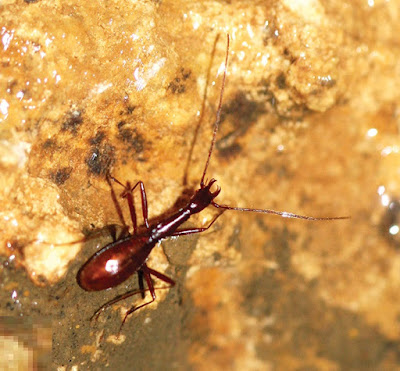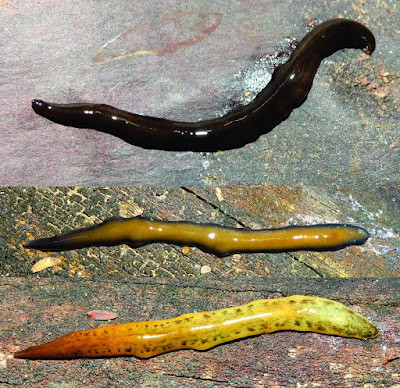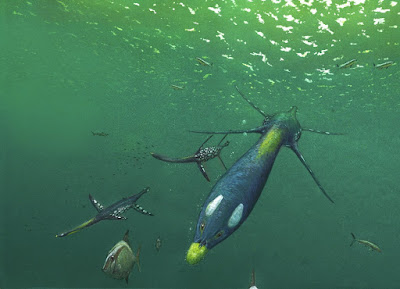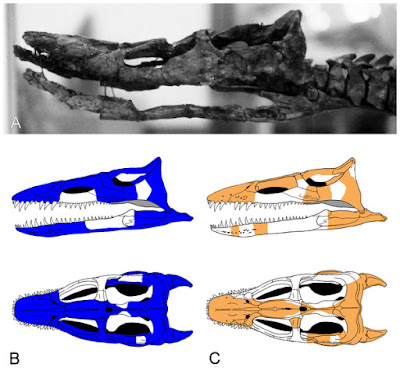[Most Recent Entries] [Calendar View]
Tuesday, January 10th, 2017
| Time | Event | ||
| 1:47a | [Entomology • 2017] Shuangheaphaenops elegans • A New Highly Cave-adapted Trechine Genus and Species (Coleoptera, Carabidae, Trechinae) from northern Guizhou Province, China
Abstract A remarkable aphaenopsian beetle, a sympatric species of Qianotrechus tenuicollis Uéno, 2000, was newly discovered in Cave Mahuang Dong of Shuanghe Dong cave system, the longest cave system of China in Suiyang County, northern Guizhou Province. To categorize this striking but still unknown species, a new genus and species are proposed: Shuangheaphaenops elegans gen. n., sp. n. Relationships of Shuangheaphaenops and other highly modified aphaenopsian genera from southern China Karsts are discussed. Keywords: aphaenopsian, ground beetle, hypogean, southern China Karsts Genus Shuangheaphaenops gen. n. Type species: Shuangheaphaenops elegans sp. n. Diagnosis: Large sized blind beetles, fore body evidently elongated and as long as elytra, shape intermediate between Uenotrechus and Dongodytes species, presence of three pairs of supraorbital setae on head, two dorsal and preapical pores on elytra, the first and second protarsomeres in male distinctly modified. Etymology: “Shuanghe + Aphaenops”. To indicate that the highly modified trechine genus occurs in Shuanghe Dong, the longest cave system in China. Shuangheaphaenops elegans sp. n. Diagnosis: A large-sized, eyeless cave trechine beetle, highly modified in morphology, with very elongated and slender body which is about four times longer than wide, fore body about as long as elytra, antennae as long as body including mandibles, extending beyond elytral apex; body glabrous, except for basal half of pronotum which is covered with erected setae. Etymology: To indicate the slender shape of this beautiful aphaenopsian beetle. Mingyi Tian. 2017. A New Highly Cave-adapted Trechine Genus and Species from northern Guizhou Province, China (Coleoptera, Carabidae, Trechinae). ZooKeys. 643: 97-108. DOI: 10.3897/zookeys.643.11050 | ||
| 3:30a | [Invertebrate • 2017] Cratera cryptolineata, C. nigrimarginata & C. aureomaculata • Three New Species of Cratera Carbayo et al., 2013 (Platyhelminthes, Continenticola) from Araucaria Forests with A Key to Species of the Genus
Abstract Areas of Araucaria moist forest have been considered to constitute hotspots of land flatworm diversity, harbouring a high number of undescribed species. Herein we describe three new species of land flatworms of Cratera Carbayo et al., 2013 occurring in such type of forest in south Brazil. The three species are differentiated from their congeners mainly by their colour pattern, anatomy of the pharynx and prostatic vesicle, and details of the penis papilla and male atrium. An identification key to species of the genus in the Neotropical region is provided. Keywords: Atlantic Forest, Geoplaninae, land flatworms, Neotropical region, taxonomy, Tricladida Taxonomy Family Geoplanidae Stimpson, 1857 Subfamily Geoplaninae Stimpson, 1857 Cratera Carbayo et al., 2013 • Cratera cryptolineata sp. n. Diagnosis: Species of Cratera with dark-brown dorsal colour, thin median stripe and greyish margins; eyes dorsal with clear halos; pharynx cylindrical; prostatic vesicle almost horizontal; penis papilla conical and symmetrical occupying distal portion of female atrium. Etymology: The specific name is a composite of the Greek adjective kryptós (hidden) and the Latin noun linea (stripe), referring to the thin median stripe, visible only under the stereomicroscope. • Cratera nigrimarginata sp. n. Diagnosis: Species of Cratera with light-brownish dorsal colour bordered by dark margins; eyes dorsal with clear halos and bilobed appearance; pharynx cylindrical; prostatic vesicle with unbranched and dilated proximal portion; tip of penis papilla with infolds projecting into ejaculatory duct; cyanophil glands pierce male atrium evenly distributed. Etymology: The specific name is a composite of the Latin adjective niger (black) and the Latin noun margo (margin), referring to the colour pattern with dark margins. • Cratera aureomaculata sp. n. Diagnosis: Species of Cratera with dorsal ground colour yellowish covered by brownish pigmentation in cephalic region and blackish pigmentation constituting irregular flecks over rest of dorsum; eyes dorsal with clear halos; pharynx cylindrical; prostatic vesicle unpaired with proximal portion displaced ventrally, laterally expanded and T-shaped; penis papilla conical and symmetrical with ventral insertion posteriorly displaced. Etymology: The specific name is a composite of the Latin adjective aureus (golden) and the Latin noun macula (spot), referring to the colour pattern with yellowish ground colour covered by black irregular flecks. Ilana Rossi and Ana Leal-Zanchet. 2017. Three New Species of Cratera Carbayo et al., 2013 from Araucaria Forests with A Key to Species of the Genus (Platyhelminthes, Continenticola). ZooKeys. 643: 1-32. DOI: 10.3897/zookeys.643.11093 Hidden diversity: 3 new species of land flatworms from the Brazilian Ara... bit.ly/2jusW5B via @Pensoft @EurekAlert | ||
| 6:45a | [Paleontology • 2016] Reappraisal of Europe’s Most Complete Early Cretaceous Plesiosaurian: Brancasaurus brancai Wegner, 1914 from the “Wealden Facies” of Germany
Abstract The holotype of Brancasaurus brancai is one of the most historically famous and anatomically complete Early Cretaceous plesiosaurian fossils. It derived from the Gerdemann & Co. brickworks clay pit near Gronau (Westfalen) in North Rhine-Westphalia, northwestern Germany. Stratigraphically this locality formed part of the classic European “Wealden facies,” but is now more formally attributed to the upper-most strata of the Bückeberg Group (upper Berriasian). Since its initial description in 1914, the type skeleton of B. brancai has suffered damage both during, and after WWII. Sadly, these mishaps have resulted in the loss of substantial information, in particular many structures of the cranium and limb girdles, which are today only evidenced from published text and/or illustrations. This non-confirmable data has, however, proven crucial for determining the relationships of B. brancai within Plesiosauria: either as an early long-necked elasmosaurid, or a member of the controversial Early Cretaceous leptocleidid radiation. To evaluate these competing hypotheses and compile an updated osteological compendium, we undertook a comprehensive examination of the holotype as it is now preserved, and also assessed other Bückeberg Group plesiosaurian fossils to establish a morphological hypodigm. Phylogenetic simulations using the most species-rich datasets of Early Cretaceous plesiosaurians incorporating revised scores for B. brancai, together with a second recently named Bückeberg Group plesiosaurian Gronausaurus wegneri (Hampe, 2013), demonstrated that referral of these taxa to Leptocleididae was not unanimous, and that the topological stability of this clade is tenuous. In addition, the trait combinations manifested by B. brancai and G. wegneri were virtually identical. We therefore conclude that these monotypic individuals are ontogenetic morphs and G. wegneri is a junior synonym of B. brancai. Finally, anomalies detected in the diagnostic features for other “Wealden” plesiosaurians have prompted reconsiderations of interspecies homology versus intraspecific variability. We therefore propose that the still unresolved taxonomy of B. brancai should emphasize only those character states evident in the examinable fossil material, and specifically accommodate for growth-related modifications delimited via osteologically mature referred specimens. ..... Conclusions The holotype specimen of Brancasaurus brancai from the uppermost strata of the Bückeberg Group (upper Berriasian) of northwestern Germany is one of the anatomically most complete Early Cretaceous plesiosaurian fossils known from Europe. Since its initial description in 1914, the specimen has suffered severe damage. Nonetheless a unique combination of diagnostic traits is present, including: rectangular conjoined frontals with a concave dorsal surface and ventrally confluent lateral sides; parietals forming a parietal table; cranial and middle cervicals with distinctly triangular neural spines; dorsal transverse processes bearing subdiapophyseal fossae; scapula with a prominent lateral shelf; pelvic bar formed by the pubes and ischia; and craniolateral cornua present at the pubes. Pointedly, the holotype specimen of B. brancai was ostologically immature, as indicated by the unfused neural arches and vertebral centra. However, other features (e.g., presence of cornuae on the pubes, and well defined epipodial facets on the propodials) indicate expression of at least ‘sub-adult’ character state development. Another but more incomplete plesiosaurian skeleton from the B. brancai type locality in the upper Bückeberg Group has been named Gronausaurus wegneri, but likely represents a more mature conspecific individual. Some variation is present in the number of dorsal/sacral vertebrae. Our phylogenies otherwise detected character state conflict only in the height of the cervical neural spines, proportions of the cervical centra, and basal constriction of the dorsal neural spines. Nevertheless, these constituted polymorphisms that probably reflect specimen completeness and/or differing ontogenetic stage, suggesting that G. wegneri represents a junior synonym of B. brancai. Finally, in our opinion, the weakly supported alternative topological nesting of B. brancai + G. wegneri either within Leptocleididae, or interpolated between Elasmosauridae and Leptocleididae + Polycotylidae dictates that the taxonomic affinities of B. brancai must, at present, remain provisional. Sven Sachs, Jahn J. Hornung and Benjamin P. Kear. 2016. Reappraisal of Europe’s Most Complete Early Cretaceous Plesiosaurian: Brancasaurus brancai Wegner, 1914 from the “Wealden Facies” of Germany. PeerJ. 4:e2813. DOI: 10.7717/peerj.2813 "Brancasaurus - a forgotten and beaten beauty" by Hyrotrioskjan hyrotrioskjan.deviantART.com/art/Brancasaurus-a-forgotten-and-beaten-beauty-564992991 |
| << Previous Day |
2017/01/10 [Calendar] |
Next Day >> |








